

Kwei-chou, VICARIATE APOSTOLIC op.—The mission of Kwei-chou embraces the entire province of that name. The country is very mountainous and is principally inhabited by Chinese emigrants from other provinces and the race of aborigines known under the generic term of Miao-tze, who are subdivided into numerous tribes. The Faith was carried for the first time into Kwei-chou by a Portuguese Jesuit towards the end of the sixteenth century. The first vicar Apostolic of the Paris Society of Foreign Missions, Msgr. Pallu, was created administrator of Kwei-chou in 1658. In 1708 Father Claude Visdelou was made vicar Apostolic of this province by Cardinal de Tour-non, but never entered upon his mission. The Holy See finally joined the mission of Kwei-chou to that of Sze-ch’wan under the direction of the Paris Society of Foreign Missions. From 1769 onwards Msgr. Pottier, Vicar Apostolic of Sze-ch’wan, Yun-nan, and Kweichou, made a practice of sending a native priest every two years to visit the few Christian communities established in Kwei-chou by Christian families migrated thither from Sze-ch’wan. The Venerable Moye visited these settlements in 1774. He was arrested, imprisoned, and eventually expelled from Kwei-chou. In 1815 Blessed Joseph Chang Ta-pong was beheaded at Tsen-i. In 1839 there were other martyrdoms, among them that of Joachim Ho. In 1846 Kwei-chou was detached from Sze-ch’wan and made an independent vicariate Apostolic. Father Stephen Albrand, missionary in Siam, was placed in charge. He found twelve hundred of the faithful in the entire province. He established himself at the capital, Kwei-yang. In 1849 he was created vicar Apostolic and consecrated titular Bishop of Sura. On January 28, 1858, the blessed martyrs, Jerome Lu Pin-mei, Laurent Wang, and Agatha Lin were decapitated at Mau-keou. In 1860 Msgr. Faurie succeeded Msgr. Albrand. This same year, because of the victories of the British and French, the Treaty of Peking guaranteeing religious liberty was signed.
The province was, however, ravaged for several years afterwards owing to feuds between the Chinese and Mohammedans. During this period Christians were imprisoned, their parishes pillaged, and their missionaries massacred. On July 29, 1861, four native Christians were beheaded at Tsin-gai. These were Blessed Joseph Chang, Paul Chen, J. B. Lo, and Martha Wang. In 1862 Blessed John Peter Neel, a French missionary, Martin Wu, John Chang, John Chen, and Lucy I were beheaded at Kai-thou. In 1865 Father Muller was massacred with several native Christians. Notwithstanding the persecution, it was possible in 1866 to record 408 baptisms of adults, and 13,178 infant baptisms among the natives. In 1867 the number baptized included 601 adults and 11,023 infant baptisms; in 1868, 902 adult and 9322 infant baptisms. Msgr. Faurie died in 1872 on his return from Rome, where he had taken part in the Vatican Council. He was succeeded by Msgr. Lions, who was consecrated titular Bishop of Basilita in 1872. Peace reigned during several years, and the missionaries were able to greatly augment the number of Christian communities, but in 1884, during the Franco-Chinese War, the persecutions were renewed. They were particularly violent in Kwei-chou. The Christians of the capital alone escaped. Hardly had this initial persecution terminated than a second, which was still more terrible, broke out, beginning with the destruction of the Catholic establishments at Chung-king (Sze-ch’wan). The Chinese priest, Father Lin, was massacred, together with his catechist and a neophyte. Many Christians were thrown into prison, and the missionaries were only able to obtain justice by application to Peking. In 1884 Msgr. Guichard had been made coadjutor to Msgr. Lions. Upon the death of the latter in 1893, Msgr. Guichard took the entire direction of the mission in hand. During the following period peace was secure in the Kwei-chou mission, and the missionaries were able to augment rapidly the number of their converts. In 1900 Kwei-chou again escaped the troubles which overwhelmed many of the other Catholic missions in China. In 1907 Msgr. Seguin was made coadjutor to Msgr. Guichard, and consecrated titular Bishop of Pinara.
In 1899 the Catholic community numbered 2 bishops, 29 missionaries, 6 native priests, 66 churches and chapels, 1 seminary with 18 students, 120 schools and orphan asylums ministering to 2031 pupils, 18,000 Catholics. In 1900: 1 bishop, 38 missionaries, 8 native priests, 86 churches and chapels, 2 seminaries with 36 students, 150 schools and asylums with 2844 scholars, 998 native adult and 4634 native infant baptisms, 19,128 Catholics. In 1908: 2 bishops, 51 missionaries, 17 native priests, 3 seminaries with 62 students, 196 schools with 2388 pupils, 13 orphan asylums with 855 children, 1472 native adult and 4713 native infant baptisms, 25,728 Catholics.
V. H. MONTANAR

